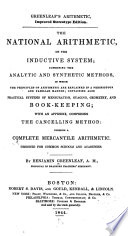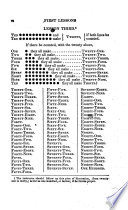 | George Hutton (arithmetic master, King's coll. sch.) - 1844 - 276 σελίδες
...-:- 7 = 3, the common difference; and the whole series 3 : 6 : 9 : 12 : 15: 18 : 21: 24. Hence the RULE. Divide the difference of the extremes by the number of terms less 1, and the quotient will be the " common difference, or ratio of the progression. EXAMPLES FOR PRACTICE.... | |
 | Charles WATERHOUSE - 1844 - 228 σελίδες
...first term, last term, and number of terms, to find tiie common difference ; or sum of all the terms. RULE. — Divide the difference of the extremes by the number of terms less 1, the quotient will be the difference. Multiply the sum of the extremes by the number of terms, and... | |
 | Benjamin Greenleaf - 1844 - 352 σελίδες
...term, last term, and the number of terms being given, to find the common difference. RULE. JDivide the difference of the extremes by the number of terms less one, and the quotient is the common difference. 1. The extremes are 3 and 45, and the number of terms is... | |
 | Horatio Nelson Robinson - 1845 - 310 σελίδες
...of the extreme terms, or mean term, by the number of terms. RULE 3. To find the common difference. Divide the difference of the extremes by the number of terms less one. RULE 4. To find the number of terms. Divide the difference of the extreme terms by the common difference,... | |
 | George Roberts Perkins - 1846 - 266 σελίδες
...first term, the last term, and the number of terms, to find the common difference, we have this • RULE. Divide the difference of the extremes by the number of terms, less one,. EXAMPLES. 1. The first term of an arithmetical progression's 5, the last term is 176, and the number... | |
 | 1846 - 258 σελίδες
...The first term, the last term, and the number of terms be ing given, to find the common difference. RULE. — (') Divide the difference of the extremes by the number of terms less 1, and the quotient will be the common difference. liiieslinn. — 1. How do you find the common difference?... | |
 | Almon Ticknor - 1846 - 274 σελίδες
...first term, the last term, and the number of terms being given, to find the common difference. RULE I. Divide the difference of the extremes by the number of terms, less 1, and the quotient will be the common difference sought. 1. The extremes are 3 and 39, and the number... | |
 | Pliny Earle Chase - 1848 - 244 σελίδες
...Then the difference of the extremes 24, must be 8 times the common difference, which is therefore 3. RULE. \ Divide the difference of the extremes by the number of terms less one, and the quotient will be the common difference. This difference repeatedly added to the less, or subtracted... | |
 | Zadock Thompson - 1848 - 184 σελίδες
...first term, the last term, and the number of terms given to find the common difference. RDI.E. — Divide the difference of the extremes by the number of terms, less 1, and the quotient will be the common difference. 2. If the first term of a series be 8, the last... | |
 | George Roberts Perkins - 1849 - 344 σελίδες
...the first term, the last term, and the number of terms, to find the common difference, we have this RULE, Divide the difference of the extremes by the number of terms, less one. EXAMPLES. 1. The first term of an arithmetical progression is 5, the last term is 176, and the number... | |
| |